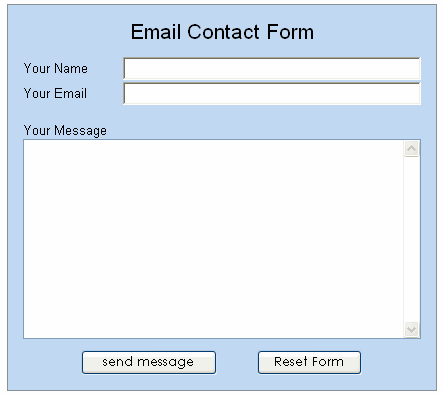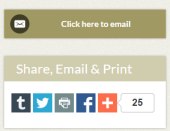Email Contact Form
easy to follow step by step guides


Our email contact form is designed to both reduce spam as well as make sure that genuine emails reach you. At the same it adds an extra professional touch to your website.
This guide explains primarily how our Email Contact Form (ECF) works, however you will also find that upon enabling the ECF, you will automatically receive an upgrade of the editor within the Administration Area. This will allow you to make the most of the ECF, and also provides useful improvements while editing. In summary, when you enable the ECF, the following changes will take place.
For more details about the upgraded Linknotes, see the section below called Creating click here to email me links. For more information about the Paragraph Control tool, see the separate EZ Guide Paragraph Control Tool. This Email Contact Form guide contains the following sections:
It is now increasingly common to see email contact forms on websites instead of clickable email addresses. There are two important reasons for this.
So, by using a form, you can make sure real contact messages arrive, while hiding your email from spam machines. The Email Contact Form developed for WebHealer clients is intended to replace links on your website which say click here to email or other links which show your full email address.
The image below shows a typical email contact form. The form has its own new special page on your website.

The form is deliberately very simple, as website visitors can be put off making contact if they are presented with a complex form with lots of sections. If you have a requirement for a more sophisticated form, WebHealer offer a more advanced upgrade option call PHD Forms, however it is always a good idea to offer a simple form as your main contact method.
The contact form has a lot of extra spam protection built in, and it is useful for you to understand this, or you may become confused. In particular please note the following:
This section explains how to switch on the Email Contact Form, and to send a test message which will both confirm that all is working, and familiarise you with the format of received messages. The steps required to do this thoroughly are as follows:
This is a very simple step. Simply log in to your Administration Area, and choose Special Features from the side menu. You will then see a section called Email Contact Form, where you can select On from the radio buttons alongisde.

When you save changes, you will notice that if you had a link in the frame area of your website which used to show your email address (or in some designs shows the text "click here to email"), it will now have been replaced by a link to the Email Contact Form. The clickable text will be click here to email. A second minor change is that when you go to your Administration login page, the text that starts "This administration page is reserved for..." used to display your email address as the address where any forgotton passwords would be sent to. That has now been removed in the interests of hiding your email address from spam robots wherever possible.
 At this point, the only way that a visitor can access the ECF is to click the link in the side menu. This is how it looks on the Social colourMAX design for example. In addition you may wish to add extra links within the wording of your pages that take visitors to the ECF. This is explained in the section Creating click here to email me links.
At this point, the only way that a visitor can access the ECF is to click the link in the side menu. This is how it looks on the Social colourMAX design for example. In addition you may wish to add extra links within the wording of your pages that take visitors to the ECF. This is explained in the section Creating click here to email me links.
First though, we should do a quick test, to make sure everything is working fine. This is explained in the next section.
Sending a test is very simple. In fact if I had to explain it, we should be worried that visitors won't know how. You are advised to remind yourself of the spam features above though, such as the 20 second rule and the back button rule.
Once you have sent the test message, you may need to wait 5 to 10 minutes for the email to reach your InBox at the address specified in the Special Features section. When you receive the email it will look like this.
|
From: "Website Enquiry (DO NOT REPLY)" <info@webhealer.net> Please note that this is an automated email sent by the WebHealer mail |
Note that the email comes from info@webhealer.net. The ECF deliberately uses this address, rather than a different one, since your email system should be used to receiving emails from this address and so it should be very rare that any emails are lost or filtered out accidentally as spam. In fact your email system very likely has a setting that can be used to make sure that it never blocks emails from info@webhealer.net. This is known as whitelisting, and the next section explains more about that.
To make sure that visitor emails are never accidentally blocked by spam filters you are advised to investigate your email spam settings, and look for an option to set the address info@webhealer.net as a trusted address. This process is often known as whitelisting - the opposite of blacklisting.
For example in Google Mail, the steps are as follows:
 and from it's drop down menu click Settings.
and from it's drop down menu click Settings.So for Gmail, you should end up with a filter that says:-
Matches: from:(info@webhealer.net)
Do this: Never send it to Spam
Note that there are other useful things you can use the filters for, such as tagging emails that have the subject line "Contact Email from www.<your website address>" so that they go in a special box to hold all your website contact messages.
Due to the huge variety of email systems available, we can't advise on the steps for whitelisting with non Gmail addresses, but we've found a page online that might be helpful depending on your own email provider. Please note that this page is not under our control, but we hope it's useful, click here to take a look. If you need more help than this though, we would encourage you to contact your email or internet service provider.
In some cases the link in the side menu which takes visitors to your ECF page is not very prominent, and you may then wish to supplement it with links at various places within your pages that say "Click here to email me" and take the visitor to the ECF.
To create "Click Here to Email" links to the ECF requires the setting up of internal links using the Linknotes editor. When you launch a website with WebHealer, linknotes is initially disabled to keep your editor simple and uncluttered. Usually clients switch on linknotes when they want to make a clickable link to go to a colleague's website, or the website of a professional organisation. If you have never used Linknotes before, then the first step is to switch on Linknotes. This is covered in Section D1 of the HELP guide in your Administration area, and you can then follow the advice in our EZ Guide Internal Links for how to create a link to your Email Contact Form.
In addition, you may already have your email displayed within your website in various places. For the best protection against spam you are advised to remove all of these, and replace them with links to your ECF.
| For protection against spam, remove instances of your email address on your website... replace them with links to your ECF |
If you do wish to keep your email address visible on your website somewhere (to remind clients who are already in contact with you perhaps) you can display it once on your Contact Me page, and to avoid spam robots grabbing it you can "disguise it". For example if your email is janesmith@hotmail.com, you could display the following:
email: janesmith-at-hotmail.com (if emailing me, please replace "-at-" with the @ symbol)